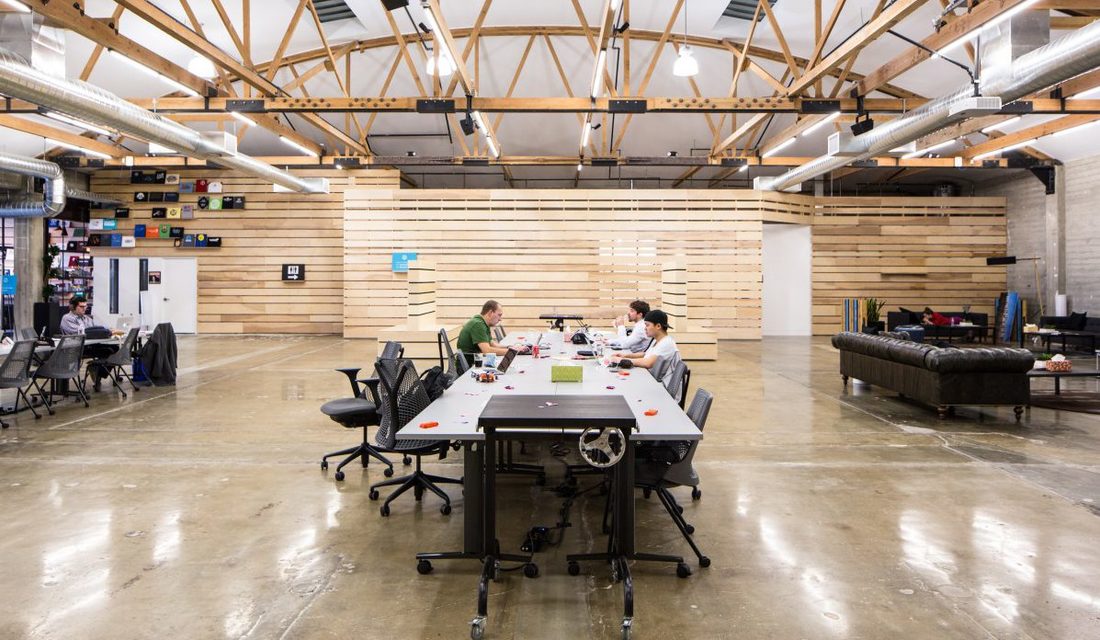Automattic, the technology company that owns WordPress.com, has a beautiful office in a converted San Francisco warehouse, with soaring ceilings, a library, and a custom-made barn door.
If you like the space, you’re free to move in.
The office at 140 Hawthorne went on the market after CEO Matt Mullenweg came to the realization not enough employees used it. As he explained on the Stack Overflow podcast earlier this year:
We got an office there about six or seven years ago, pretty good lease, but nobody goes in it. Five people go in it and it’s 15,000 square feet. They get like 3,000 square feet each. … There are as many gaming tables as there are people.
Automattic has always given its 550 employees the choice of working remotely; the San Francisco space was an optional co-working space, spokesman Mark Armstrong said. The company maintains similar offices in Cape Town, South Africa, and outside Portland, Maine, and gives employees a $250-a-month stipend if they want to use commercial co-working offices elsewhere. And if they’d rather work at Starbucks, Automattic will pay for their coffee.
While Automattic fervently embraces remote working, other companies have gotten cold feet. In 2013, Marissa Mayer, then the CEO of Yahoo, famously ended the company telecommuting policy, telling employees in a memo from HR that for the best results “we need to be working side-by-side.”
More recently, IBM—a pioneer of remote working—told thousands of US employees they’ll need to begin working in offices. The goal is to make the company’s workforce more nimble and, similar to Yahoo’s aim, to foster creativity through working “shoulder-to-shoulder.” But to employees who have built a life around working from home, IBM’s still-theoretical productivity gains come as small consolation.
About a quarter of US employees work remotely all or some of the time, according to Gallup. There’s evidence that these employees work longer hours than their office-bound colleagues. But it can come with costs.
Elastic, a software company, has no headquarters and 500 employees in about 35 countries. To build a common culture, the company brings them together periodically, flying hundreds of engineers to the US or Europe to meet twice a year, said CEO Shay Banon. When employees don’t know each other, and their only interactions are via email, text, or messaging services like Slack, “disputes can blow up very quickly,” Banon said. “If you don’t see facial expressions, you miss cues.”
To prevent conflicts from escalating, Elastic maintains a constant video channel. “One of the rules we have is when something gets to a boiling point, go to video and chat it out,” he said.
June 12, 2017
We got an office there about six or seven years ago, pretty good lease, but nobody goes in it. Five people go in it and it’s 15,000 square feet. They get like 3,000 square feet each. … There are as many gaming tables as there are people.
Automattic has always given its 550 employees the choice of working remotely; the San Francisco space was an optional co-working space, spokesman Mark Armstrong said. The company maintains similar offices in Cape Town, South Africa, and outside Portland, Maine, and gives employees a $250-a-month stipend if they want to use commercial co-working offices elsewhere. And if they’d rather work at Starbucks, Automattic will pay for their coffee.
While Automattic fervently embraces remote working, other companies have gotten cold feet. In 2013, Marissa Mayer, then the CEO of Yahoo, famously ended the company telecommuting policy, telling employees in a memo from HR that for the best results “we need to be working side-by-side.”
More recently, IBM—a pioneer of remote working—told thousands of US employees they’ll need to begin working in offices. The goal is to make the company’s workforce more nimble and, similar to Yahoo’s aim, to foster creativity through working “shoulder-to-shoulder.” But to employees who have built a life around working from home, IBM’s still-theoretical productivity gains come as small consolation.
About a quarter of US employees work remotely all or some of the time, according to Gallup. There’s evidence that these employees work longer hours than their office-bound colleagues. But it can come with costs.
Elastic, a software company, has no headquarters and 500 employees in about 35 countries. To build a common culture, the company brings them together periodically, flying hundreds of engineers to the US or Europe to meet twice a year, said CEO Shay Banon. When employees don’t know each other, and their only interactions are via email, text, or messaging services like Slack, “disputes can blow up very quickly,” Banon said. “If you don’t see facial expressions, you miss cues.”
To prevent conflicts from escalating, Elastic maintains a constant video channel. “One of the rules we have is when something gets to a boiling point, go to video and chat it out,” he said.
June 12, 2017

 RSS Feed
RSS Feed
